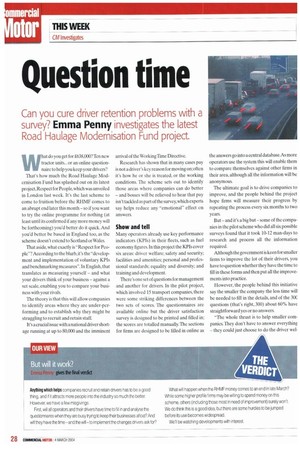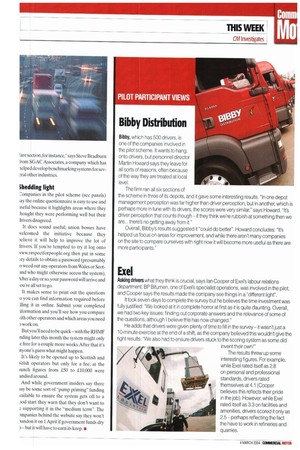Question ti
Page 28

Page 29

If you've noticed an error in this article please click here to report it so we can fix it.
Can you cure driver retention problems with a
survey? Emma Penny investigates the latest
Road Haulage Vodernisation Fund project.
What do you get for £638,000? Ten new tractor units... or an online questionnaire to help you keep your drivers? That's how much the Road Haulage Modernisation Fund has splashed out on its latest project. Respect for People, which was unveiled in London last week. It's the last scheme to come to fruition before the RHMF comes to an abrupt end later this month —so if you want to try the online programme for nothing (at least until its confirmed if any more money will be forthcoming) you'd better do it quick. And you'd better be based in England too, as the scheme doesn't extend to Scotland or Wales.
That aside, what exactly is "Respect for People"? According to the blurb, it's the "development and implementation of voluntary KPIs and benchmarking measures". In English, that translates as measuring yourself — and what your drivers think of your business — against a set scale, enabling you to compare your business with your rivals.
The theory is that this will allow companies to identify areas where they are under-performing and to establish why they might be struggling to recruit and retain staff.
It's a crucial issue with a national driver shortage running at up to 80,000 and the imminent arrival of the WorkingTime Directive.
Research has shown that in many cases pay is not a driver's key reason for moving on; often it's how he or she is treated, or the working conditions. The scheme sets out to identify those areas where companies can do better — and bosses will be relieved to hear that pay isn't tackled as part of the survey,which experts say helps reduce any "emotional" effect on answers.
Show and tell
Many operators already use key performance indicators (KPIs) in their fleets, such as fuel economy figures. In this project the KPIs cover six areas: driver welfare; safety and security; facilities and amenities; personal and professional standards; equality and diversity: and training and development.
There's one set of questions for management and another for drivers. In the pilot project, which involved 15 transport companies, there were some striking differences between the two sets of scores. The questionnaires are available online but the driver satisfaction survey is designed to be printed and filled in; the scores are totalled manually. The sections for firms are designed to be filled in online as the answers go into a central database. As more operators use the system this will enable them to compare themselves against other firms in their area, although all the information will be anonymous.
The ultimate goal is to drive companies to improve, and the people behind the project hope firms will measure their progress by repeating the process every six months to two years.
But — and it's a big but — some of the companies in the pilot scheme who did all six possible surveys found that it took 10-12 man-days to research and process all the information required.
Although the govenunent is keen for smaller firms to improve the lot of their drivers, you have to question whether they have the time to fill in these forms and then put all the improvements into practice.
However, the people behind this initiative say the smaller the company the less time will be needed to fill in the details, and of the 30C questions (that's right, 300) about 60% have straightforward yes or no answers.
"The whole thrust is to help smaller companies. They don't have to answer everything — they could just choose to do the driver wel fare section. for instance," says Steve Bradburn from SGAC Associates, a company which has ielped develop benchmarking systems for sev:ral other industries.
;hedding light Annpinues in the pilot scheme (see panels) iay the online questionnaire is easy to use and iseful because it highlights areas where they hought they were performing well but their 'rivers disagreed.
It does sound useful; union bosses have velcomed the initiative because they ielieve it will help to improve the lot of !rivers. If you're tempted to try it log onto vww.respectforpeople.org then put in some :ey details to obtain a password (presumably o weed out any operators from Wales or Scotand who might otherwise access the system). Oer a day or so, your password will arrive and ou're all set to go.
It makes sense to print out the questions o you can find information required before fling it in online. Submit your completed iformation and you'll see how you compare fith other operators and which areas you need work on.
But you'll need to be quick with the RH-MY nding later this month the system might only e free for a couple more weeks. After that it's nyone's guess what might happen.
It's likely to be opened up to Scottish and Velsh operators but only for a fee: at the lunch figures from £50 to £10,000 were andied around.
And while government insiders say there lay be some sort of -pump priming" funding vailable to ensure the system gets off to a :iod start they warn that they don't want to supporting it in the "medium term". The impanies behind the website say they won't landon it on 1 April if government funds dry 1hut it will have to earn its keep. •


































































































































































































